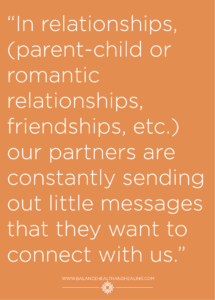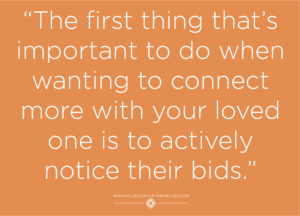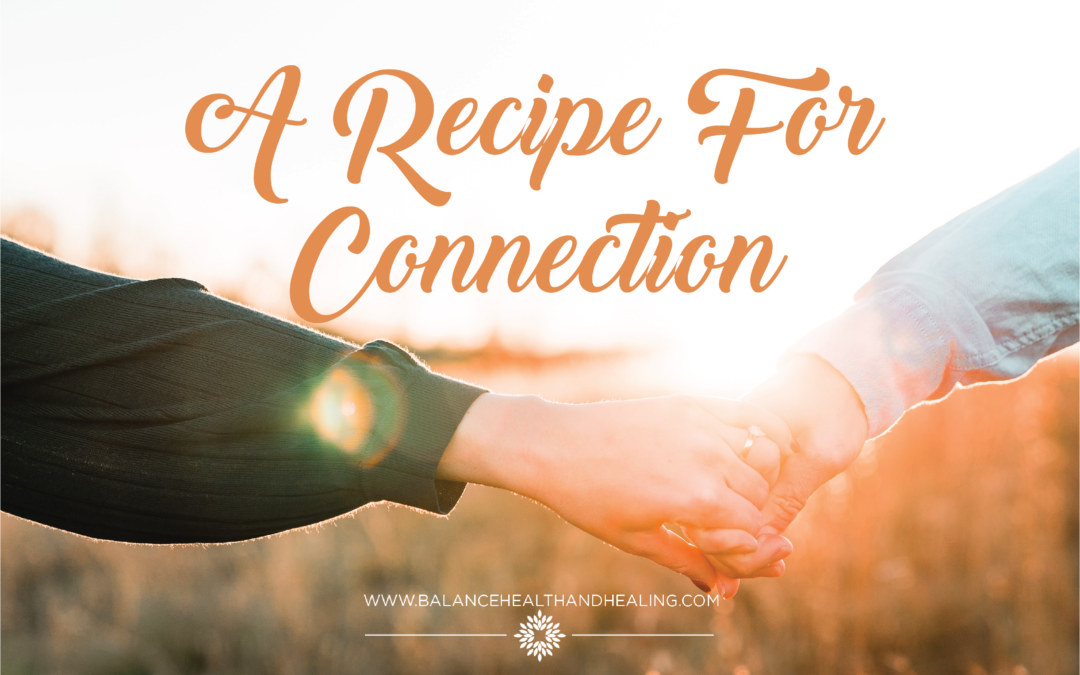 I am the youngest in my family by 12 years. You read that right, my sisters were 18 and 16 and my brother was 12 when I was born. Because of the large age gap, my brother and I haven’t necessarily had the typical sibling relationship. I’m not the best at keeping in touch with him by phone but we make time to see each other 3-4 times per year. I spent about a week with him over holidays and loved our time together talking, playing games, and cooking. My brother and I both really love cooking and trying out new recipes. The other day I got a text from him with a recipe for shrimp and grits (YUM). I quickly replied, “Yum! We’ll have to try it out. Thanks!” As I began to move onto other things, I thought about it for a second. Why did my brother send me the recipe? He could have sent it to me for a few reasons. 1. To show off his cooking skills and refined palette 2. Because he knows I like cooking and trying new things 3. To connect with me. Now, I haven’t talked with him to confirm my theory, but I’m guessing it was a mix of all three. My quick response to his text message would have allowed me to miss out on connecting with him more fully. Instead, I decided to call him, which is pretty unusual for me to do. We talked on the phone for his entire 1-hour commute home. I hung up feeling rejuvenated and grateful to be related to such a good human.
I am the youngest in my family by 12 years. You read that right, my sisters were 18 and 16 and my brother was 12 when I was born. Because of the large age gap, my brother and I haven’t necessarily had the typical sibling relationship. I’m not the best at keeping in touch with him by phone but we make time to see each other 3-4 times per year. I spent about a week with him over holidays and loved our time together talking, playing games, and cooking. My brother and I both really love cooking and trying out new recipes. The other day I got a text from him with a recipe for shrimp and grits (YUM). I quickly replied, “Yum! We’ll have to try it out. Thanks!” As I began to move onto other things, I thought about it for a second. Why did my brother send me the recipe? He could have sent it to me for a few reasons. 1. To show off his cooking skills and refined palette 2. Because he knows I like cooking and trying new things 3. To connect with me. Now, I haven’t talked with him to confirm my theory, but I’m guessing it was a mix of all three. My quick response to his text message would have allowed me to miss out on connecting with him more fully. Instead, I decided to call him, which is pretty unusual for me to do. We talked on the phone for his entire 1-hour commute home. I hung up feeling rejuvenated and grateful to be related to such a good human.
What is a “bid” for connection?
This experience reminds me of a principle taught by Dr. John Gottman. In relationships, (parent-child or romantic relationships, friendships, etc.) our partners are constantly sending out little messages that they want to connect with us. Gottman calls these messages “bids.” Grabbing your boyfriend’s hand while walking into the grocery store? Bid for connection. Texting your child a song that reminds you of him/her? Bid for connection. Pointing out the beautiful sunset on a drive home with a friend? Bid for connection. Sending your sister a recipe for shrimp and grits? Absolutely a bid for connection. I’ve attached more examples of what bids can look like at the end of this article.
What do we do with “bids”?
Now that we know what a bid looks like, what do we do?
- The first thing that’s important to do when wanting to connect more with your loved one is to actively notice their bids. What things does your loved one do to
 try to connect with you? Can you have bids on your mind the next time you’re with him/her? It’s pretty difficult to respond to bids or allow bids to be connecting if you aren’t aware of what your partners’ bids look like. Maybe even have a conversation with him or her. You might ask, “What do you do when you’re wanting to connect with me?” In my shrimp and grits story, me questioning why my brother sent the text was my way of noticing his bid.
try to connect with you? Can you have bids on your mind the next time you’re with him/her? It’s pretty difficult to respond to bids or allow bids to be connecting if you aren’t aware of what your partners’ bids look like. Maybe even have a conversation with him or her. You might ask, “What do you do when you’re wanting to connect with me?” In my shrimp and grits story, me questioning why my brother sent the text was my way of noticing his bid. - Gottman calls this responding process “turning towards.” When we acknowledge our loved ones’ attempt at connection and intimacy, we are able to take the opportunity to connect with them. It can be pretty vulnerable to bid for connection and when we treat our partners’ bids with care and love, more bids are likely to follow in the future. On the flip side, our non-response can have an impact as well. Gottman calls this “turning away” from bids for connection. Using an example above, imagine pointing out a beautiful sunset to your friend on your drive home. You love nature. It’s meaningful and grounding for you. Your friend takes a second to look at the sunset and comments, “Oh wow! We live in such a beautiful place.” Although this interaction is brief, you feel more connected to your friend and seen by him or her as she “turned towards” your bid. On the flip side, if your friend was on his or her phone and ignored your bid, there would have been a missed opportunity for connection. Although this is a small example and doesn’t hold massive consequences in and of itself, the principle remains the same whether you’re bidding for connection with a friend through a beautiful sunset or bidding for connection from your partner by initiating sex. The way we respond to bids matters in growing closer or creating more distance in any relationship.
- Bid yourself. Now that you understand what bids are and what purpose they serve, you may want to examine what bids look like in your life. How do you bid for connection with those you love? How do they respond? In what ways would you like to bid more often in your relationships? What keeps you from bidding for connection with those you love? If your partner is consistently bidding for connection and you aren’t reciprocating, figure out ways that you can bid more in your relationship. I believe that a “bid” is really a small way that you’re asking for what you need from your partner: attention, help, reassurance, affection, etc. How can you ask for what you need by using bids?
We all want to feel connected to those in our lives. We are constantly getting opportunities to establish connection and intimacy in our relationships. As I’ve understood the idea of bids more, I’ve been able to recognize these more in my life and respond to them in ways that foster connection. The recipe for shrimp and grits was actually an invitation and deepening my relationship with my brother and I almost missed it!
Here’s a helpful link to a video that explains bids and their usefulness in your couple relationships.
References:
Gottman, J. M., & Silver, N. (1999). The seven principles for making marriage work. New York: Three Rivers Press.

